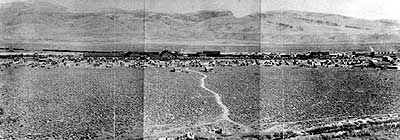|
Page
114
|
 Panoramic
view of Pocatello from the West Bench in about 1889. The townsite had
been restricted until the previous year by the Fort Hall Indian Reservation,
upon which construction or occupation by non-Indians was illegal. In 1889
Pocatello was most certainly a company town. Pocatello Creek is the prominent
canyon in the center background. Directly below it is Oregon Short Line
shop facility and the old coal tipple (long dark building). The original
route of the Utah & Northern Railway is the faint white line on the
flat in the middle distance. The narrow gauge Utah & Northern tracks
head north in the left center, along the present-day Yellowstone Branch.
The Y-shaped area between the Oregon Short Line and the Utah & Northern
became a logical place for the railroad shops. This necessitated expansion
of the railroad's facilities which was accomplished by the treaty of 1888.
On the extreme right is the Pacific Hotel, a combination passenger station,
hotel, and dining room for railroad passengers. The Mansard Roof was added
in about 1885. The Freight Depot is in the middle right north of the Pacific
Hotel. The square houses on the left center of the photo are along North
Harrison Street and comprise Company Row, made of houses moved into Pocatello
from Eagle Rock, Battle Creek, and Omaha by the railroad to house employees.
Panoramic
view of Pocatello from the West Bench in about 1889. The townsite had
been restricted until the previous year by the Fort Hall Indian Reservation,
upon which construction or occupation by non-Indians was illegal. In 1889
Pocatello was most certainly a company town. Pocatello Creek is the prominent
canyon in the center background. Directly below it is Oregon Short Line
shop facility and the old coal tipple (long dark building). The original
route of the Utah & Northern Railway is the faint white line on the
flat in the middle distance. The narrow gauge Utah & Northern tracks
head north in the left center, along the present-day Yellowstone Branch.
The Y-shaped area between the Oregon Short Line and the Utah & Northern
became a logical place for the railroad shops. This necessitated expansion
of the railroad's facilities which was accomplished by the treaty of 1888.
On the extreme right is the Pacific Hotel, a combination passenger station,
hotel, and dining room for railroad passengers. The Mansard Roof was added
in about 1885. The Freight Depot is in the middle right north of the Pacific
Hotel. The square houses on the left center of the photo are along North
Harrison Street and comprise Company Row, made of houses moved into Pocatello
from Eagle Rock, Battle Creek, and Omaha by the railroad to house employees.
There are at least two reasons this picture looks alien. The mountains in the background have been retouched and thus can not be matched to the actual mountains. Secondly, there are no trees. All the trees in Pocatello have been planted, as indeed have all the trees except cottonwoods and junipers from here west to Boise. Photo from Abe Lillibridge collection, Idaho State University.
 Panoramic
view of Pocatello in 1895 (population 4,000), from the west, along Highland
Drive (leading to the West (Valleyview) Bench). Red Hill occupies the middle
right distance. Chink's Peak is in the right skyline with Camelback Mountain
behind and to its left. The Portneuf River meanders through marshy ground,
which in 1899 was developed into a hydroelectric dam and race. In the early
20th century, houses and Raymond Park were built on the river flood plain.
This unwise construction of homes led to repeated flood damage, first in
1911 and periodically until 1963. A concrete channel was built along the
Portneuf by the U.S. Army Corps of Engineers and finished in 1965. The fenced
compound between the city and the river surrounds St. Joseph's Catholic
Church, school, and convent. Pocatello High School, built in 1894, is the
largest building on the west side of the tracks. Photo from Abe Lillibridge
collection, Idaho State University.
Panoramic
view of Pocatello in 1895 (population 4,000), from the west, along Highland
Drive (leading to the West (Valleyview) Bench). Red Hill occupies the middle
right distance. Chink's Peak is in the right skyline with Camelback Mountain
behind and to its left. The Portneuf River meanders through marshy ground,
which in 1899 was developed into a hydroelectric dam and race. In the early
20th century, houses and Raymond Park were built on the river flood plain.
This unwise construction of homes led to repeated flood damage, first in
1911 and periodically until 1963. A concrete channel was built along the
Portneuf by the U.S. Army Corps of Engineers and finished in 1965. The fenced
compound between the city and the river surrounds St. Joseph's Catholic
Church, school, and convent. Pocatello High School, built in 1894, is the
largest building on the west side of the tracks. Photo from Abe Lillibridge
collection, Idaho State University.